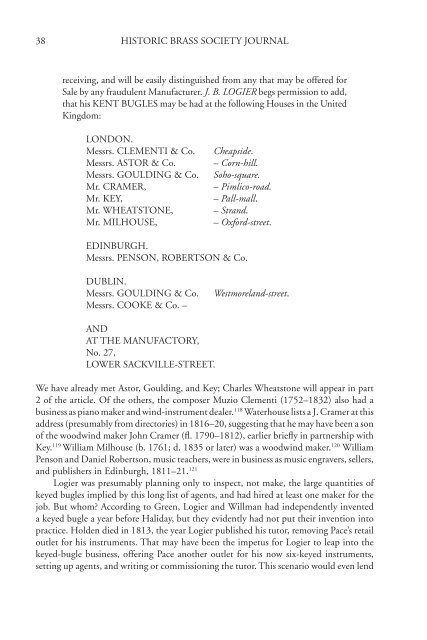New Light on the Early History of the Keyed Bugle Part I: The Astor ...
New Light on the Early History of the Keyed Bugle Part I: The Astor ...
New Light on the Early History of the Keyed Bugle Part I: The Astor ...
You also want an ePaper? Increase the reach of your titles
YUMPU automatically turns print PDFs into web optimized ePapers that Google loves.
38<br />
HISTORIC BRASS SOCIETY JOURNAL<br />
receiving, and will be easily distinguished from any that may be <strong>of</strong>fered for<br />
Sale by any fraudulent Manufacturer. J. B. LOGIER begs permissi<strong>on</strong> to add,<br />
that his KENT BUGLES may be had at <strong>the</strong> following Houses in <strong>the</strong> United<br />
Kingdom:<br />
LONDON.<br />
Messrs. CLEMENTI & Co.<br />
Messrs. ASTOR & Co.<br />
Messrs. GOULDING & Co.<br />
Mr. CRAMER,<br />
Mr. KEY,<br />
Mr. WHEATSTONE,<br />
Mr. MILHOUSE,<br />
Cheapside.<br />
– Corn-hill.<br />
Soho-square.<br />
– Pimlico-road.<br />
– Pall-mall.<br />
– Strand.<br />
– Oxford-street.<br />
EDINBURGH.<br />
Messrs. PENSON, ROBERTSON & Co.<br />
DUBLIN.<br />
Messrs. GOULDING & Co.<br />
Messrs. COOKE & Co. –<br />
Westmoreland-street.<br />
AND<br />
AT THE MANUFACTORY,<br />
No. 27,<br />
LOWER SACKVILLE-STREET.<br />
We have already met <strong>Astor</strong>, Goulding, and Key; Charles Wheatst<strong>on</strong>e will appear in part<br />
2 <strong>of</strong> <strong>the</strong> article. Of <strong>the</strong> o<strong>the</strong>rs, <strong>the</strong> composer Muzio Clementi (1752–1832) also had a<br />
business as piano maker and wind-instrument dealer. 118 Waterhouse lists a J. Cramer at this<br />
address (presumably from directories) in 1816–20, suggesting that he may have been a s<strong>on</strong><br />
<strong>of</strong> <strong>the</strong> woodwind maker John Cramer (fl. 1790–1812), earlier briefly in partnership with<br />
Key. 119 William Milhouse (b. 1761; d. 1835 or later) was a woodwind maker. 120 William<br />
Pens<strong>on</strong> and Daniel Roberts<strong>on</strong>, music teachers, were in business as music engravers, sellers,<br />
and publishers in Edinburgh, 1811–21. 121<br />
Logier was presumably planning <strong>on</strong>ly to inspect, not make, <strong>the</strong> large quantities <strong>of</strong><br />
keyed bugles implied by this l<strong>on</strong>g list <strong>of</strong> agents, and had hired at least <strong>on</strong>e maker for <strong>the</strong><br />
job. But whom? According to Green, Logier and Willman had independently invented<br />
a keyed bugle a year before Haliday, but <strong>the</strong>y evidently had not put <strong>the</strong>ir inventi<strong>on</strong> into<br />
practice. Holden died in 1813, <strong>the</strong> year Logier published his tutor, removing Pace’s retail<br />
outlet for his instruments. That may have been <strong>the</strong> impetus for Logier to leap into <strong>the</strong><br />
keyed-bugle business, <strong>of</strong>fering Pace ano<strong>the</strong>r outlet for his now six-keyed instruments,<br />
setting up agents, and writing or commissi<strong>on</strong>ing <strong>the</strong> tutor. This scenario would even lend

















